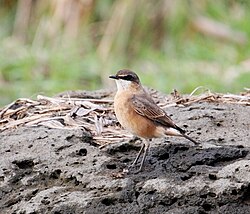| Rusty-breasted wheatear | |
|---|---|
 | |
| In Ethiopia | |
| Scientific classification | |
| Kingdom: | Animalia |
| Phylum: | Chordata |
| Class: | Aves |
| Order: | Passeriformes |
| Family: | Muscicapidae |
| Genus: | Oenanthe |
| Species: | O. frenata |
| Binomial name | |
| Oenanthe frenata (Heuglin, 1869) | |
The rusty-breasted wheatear (Oenanthe frenata) is a species of bird in the Old World flycatcher family Muscicapidae that is native to the Ethiopian Highlands.
The rusty-breasted wheatear was formerly considered to be a subspecies of the red-breasted wheatear(Oenanthe bottae) which is now renamed the buff-breasted wheatear. [2] [3]
